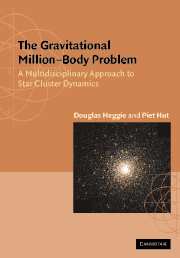Book contents
- Frontmatter
- Contents
- Preface
- PART I INTRODUCTIONS
- PART II THE CONTINUUM LIMIT: N → ∞
- 5 Paradoxical Thermodynamics
- 6 Statistical Mechanics
- 7 Motion in a Central Potential
- 8 Some Equilibrium Models
- 9 Methods
- PART III MEAN FIELD DYNAMICS: N = 106
- PART IV MICROPHYSICS: N = 2
- PART V GRAVOTHERMODYNAMICS: N = 106
- PART VI GRAVITATIONAL SCATTERING: N = 3
- PART VII PRIMORDIAL BINARIES: N = 4
- PART VIII POST-COLLAPSE EVOLUTION: N = 106
- PART IX STAR CLUSTER ECOLOGY
- Appendix A A Simple N-Body Integrator
- Appendix B Hints to Solution of Problems
- References
- Index
9 - Methods
Published online by Cambridge University Press: 05 June 2012
- Frontmatter
- Contents
- Preface
- PART I INTRODUCTIONS
- PART II THE CONTINUUM LIMIT: N → ∞
- 5 Paradoxical Thermodynamics
- 6 Statistical Mechanics
- 7 Motion in a Central Potential
- 8 Some Equilibrium Models
- 9 Methods
- PART III MEAN FIELD DYNAMICS: N = 106
- PART IV MICROPHYSICS: N = 2
- PART V GRAVOTHERMODYNAMICS: N = 106
- PART VI GRAVITATIONAL SCATTERING: N = 3
- PART VII PRIMORDIAL BINARIES: N = 4
- PART VIII POST-COLLAPSE EVOLUTION: N = 106
- PART IX STAR CLUSTER ECOLOGY
- Appendix A A Simple N-Body Integrator
- Appendix B Hints to Solution of Problems
- References
- Index
Summary
In stellar dynamics we do not really study stellar systems like globular clusters and galaxies. That is the job of astronomers. What we do is study models of these systems. Just as in many branches of applied mathematics, a model is nothing other than a mathematical structure into which we try to incorporate our knowledge of the system at hand. Sometimes “knowledge” is not the right word: it may be nothing better than a hunch about how things might work. Often, however, our knowledge will include physical laws, especially the ones we think are relevant. So far in this book, for example, we have implicitly thrown out almost everything we know about stellar systems except the gravitational dynamics.
In the context of stellar dynamics, a model consists of two kinds of mathematical construct. One is the mathematical object used in the description of the system, and the other is the evolution which determines its evolution. So far, for example, we have introduced the N-body model, where the system is described by N time-dependent vectors, which evolve according to Newton's Law of motion. We have also introduced a statistical model of collisionless stellar dynamics, where the system is described by the one-particle distribution function f, which evolves according to the collisionless Boltzmann equation.
In this final chapter of Part II we give a foretaste of the full variety of models for the dynamics of dense stellar systems.
- Type
- Chapter
- Information
- The Gravitational Million–Body ProblemA Multidisciplinary Approach to Star Cluster Dynamics, pp. 78 - 90Publisher: Cambridge University PressPrint publication year: 2003



